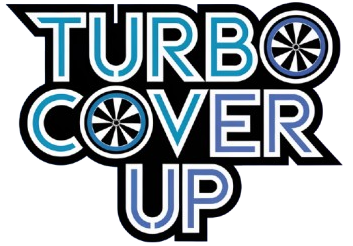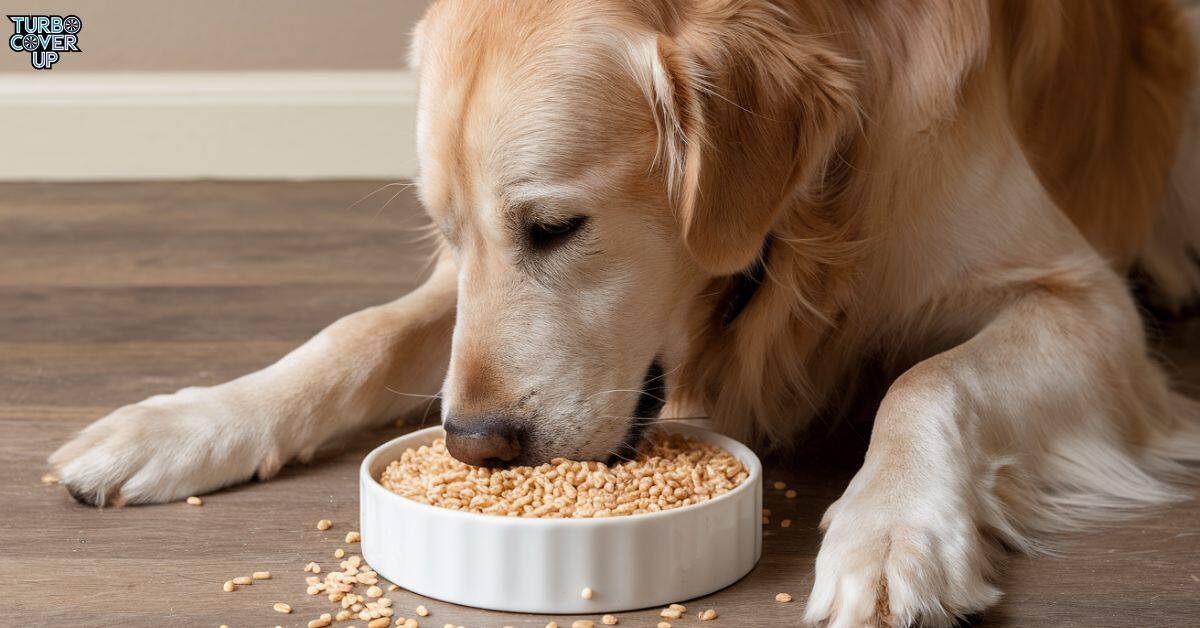Farro, an ancient grain packed with nutrients, has recently gained popularity in human diets. But as a dog owner, you may wonder if it’s safe to share this healthy grain with your pet. The good news is that dogs can eat farro, but there are a few things to keep in mind.
While Farro offers benefits like protein, fiber, and vitamins, it’s important to introduce it slowly and watch for any signs of allergies or digestive issues. Moderation is key and always check with your vet before adding farro to your dog’s meals.
What Is Farro?
Farro is an ancient grain that has been a staple food in Mediterranean diets for centuries. Its nutty flavor and chewy texture make it a popular addition to salads, soups, and grain bowls. Farro is often confused with similar grains like barley or wheat berries.
This whole grain is packed with nutrients, including protein, fiber, and essential vitamins like magnesium and iron. It provides a healthy energy source and can be a great alternative to rice or pasta.
In addition to its health benefits, farro is versatile and easy to cook. It can be boiled and added to various dishes, absorbing flavors well while maintaining its texture. Whether you’re looking to boost your nutrition or try something new, farro is a great grain to add to your diet.
Types of Farro
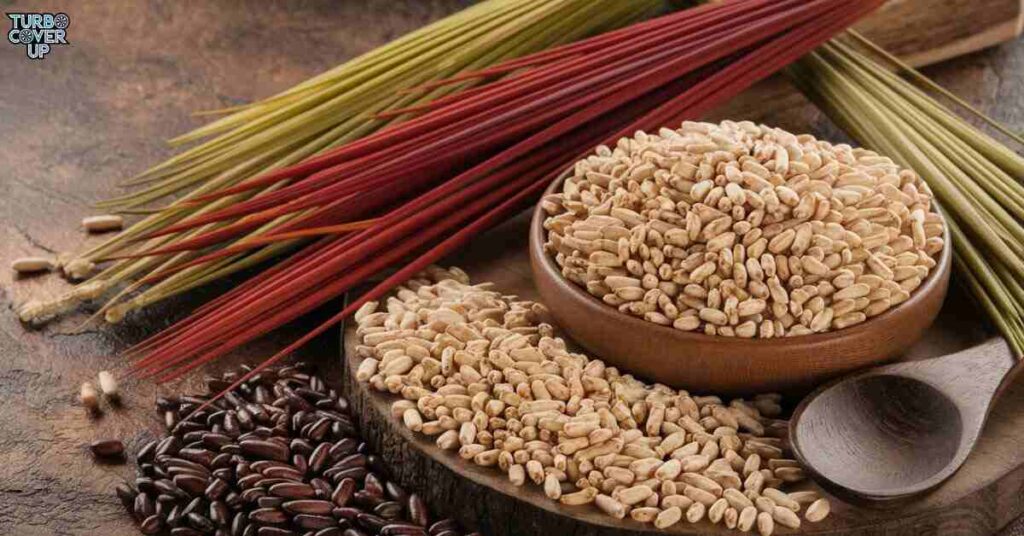
Farro comes in three main types: emmer, einkorn, and spelt, each with different levels of fiber.
Emmer: Emmer is one of the most common types of farro, often referred to as “true” farro. It has a rich, nutty flavor and is slightly chewy when cooked. Emmer is packed with nutrients like fiber and protein, making it a healthy grain choice.
Einkorn: Einkorn is the oldest type of farro and has a mild, sweet flavor. It’s smaller than other varieties and contains much protein and nutrients. Its softer texture makes it easy to cook and a healthy grain option.
Spelt: Spelt is a popular type of farro with a nutty taste and chewy texture. It’s larger than Einkorn and Emmer but still packed with fiber and nutrients. Spelt is often used in bread and pasta for its hearty flavor.
Nutritional Profile of Farro
Farro is a nutrient-rich grain, high in fiber and protein, making it great for keeping you full longer. It also contains essential vitamins like B vitamins and minerals such as magnesium and iron. These nutrients support energy levels and overall health.
Farro is lower in calories than many other grains but still provides a solid source of complex carbohydrates. This makes it a healthy option for those looking to manage their weight or boost their energy. Its slow-digesting carbs offer a steady release of energy.
Farro is packed with antioxidants, which help protect your body from damage caused by free radicals. These compounds reduce inflammation and lower the risk of chronic diseases. Eating farro can contribute to a balanced, wholesome diet.
Can Dogs Eat Farro Safely?
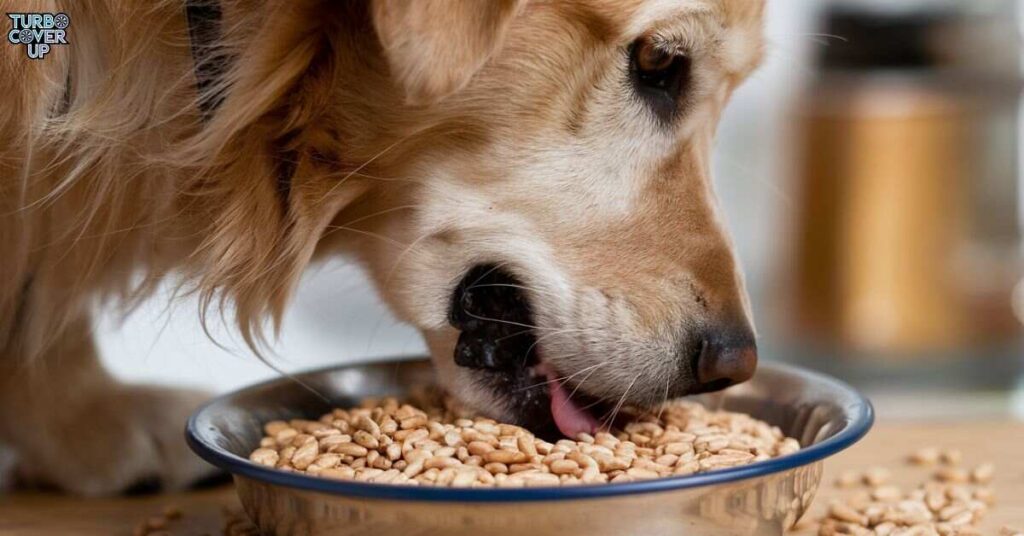
Yes, dogs can eat farro safely in small amounts, as it’s a whole grain that offers fiber and nutrients. It can be a healthy addition to your dog’s diet, but only if it’s plain and cooked properly. Avoid adding salt, spices, or sauces.
Farro is not toxic to dogs but it should be introduced slowly to avoid any digestive upset. Some dogs may have sensitivities to grains, so watch for signs like vomiting or diarrhea after eating. Always consult your vet before adding new foods to your dog’s diet.
If your dog has a wheat allergy or grain sensitivity, farro might not be suitable. While it’s packed with nutrients, farro contains gluten, which some dogs can’t tolerate. In moderation and with your vet’s approval, farro can be a safe treat.
Gluten for Dogs
Gluten is a type of protein found in certain grains, including farro. It helps give structure and elasticity to baked goods, which is why it’s valued in cooking and baking. In farro, gluten is responsible for its chewy texture, making it appealing in various dishes.
While gluten is safe for most dogs, some dogs may have sensitivities or allergies to it, which can lead to digestive issues or skin problems. If a dog has a wheat allergy or gluten intolerance, consuming farro could cause adverse reactions.
It’s essential to observe your dog for any signs of discomfort, such as vomiting, diarrhea, or itching, after introducing gluten-containing foods like farro. Always consult your veterinarian before adding new grains to your dog’s diet, especially if they have known sensitivities.
Health Benefits of Farro for Dogs
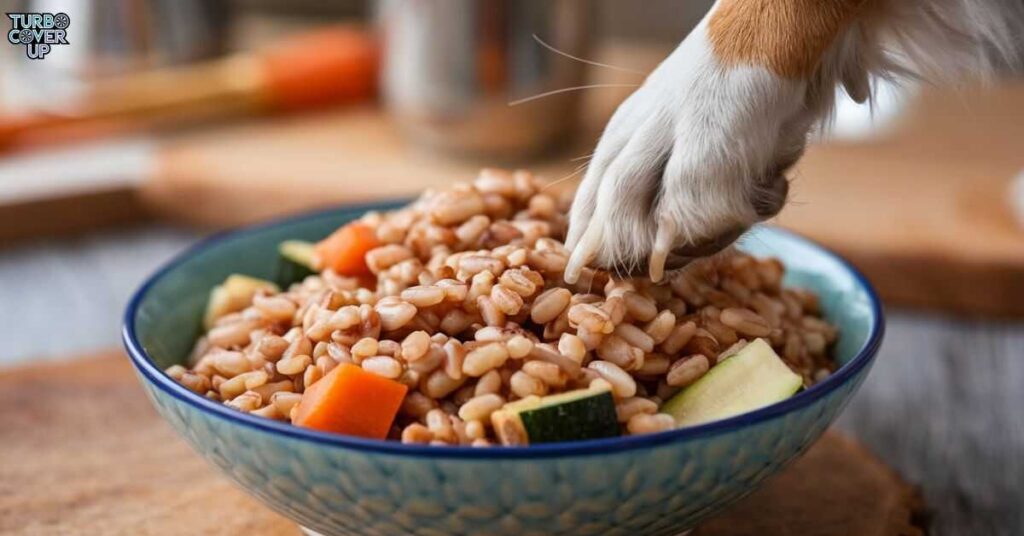
Farro is a nutritious ancient grain that can offer several health benefits for dogs. Rich in fiber, protein, and essential nutrients, it supports digestion and overall health. Including farro in your dog’s diet can provide energy and promote a healthy coat, making it a great addition to their meals.
Digestive Health
Farro can improve digestive health in dogs due to its high fiber content. Fiber helps regulate bowel movements, preventing constipation and promoting a healthy gut. Including farro in your dog’s diet can support their overall digestive system, making it easier for them to absorb nutrients.
Nutritional Advantages
Farro offers several nutritional advantages for dogs, as it is packed with essential vitamins and minerals. It contains protein, which helps build and repair muscles, and antioxidants that support a healthy immune system. Additionally, farro provides energy and keeps dogs feeling full, making it a nutritious addition to their meals.
Supporting the Immune System
Farro can help support a dog’s immune system due to its rich antioxidant content. These antioxidants fight off harmful free radicals, which can lead to illness and disease. By including farro in their diet, dogs may enjoy better overall health and improved immune function.
Weight Management
Farro can help with weight management for dogs due to its high fiber content. This fiber keeps dogs feeling full for longer, which can reduce their overall food intake. Including farro in their diet may promote healthy weight loss and maintenance while providing essential nutrients.
Skin and Coat Health
Farro can contribute to better skin and coat health in dogs due to its rich nutrient content. It contains vitamins like B and E, which help maintain a shiny coat and support healthy skin. By adding farro to their diet, dogs may enjoy a healthier appearance and reduced skin issues.
Energy and Blood Sugar Control
Farro can help dogs maintain steady energy levels throughout the day. Farro has a low glycemic index. Its complex carbohydrates are digested slowly, preventing sudden spikes in blood sugar. This gradual release of energy helps keep dogs active and focused, making it a great addition to their diet.
Potential Risks and Side Effects
While Farro can be a healthy addition to your dog’s diet, it’s important to be aware of potential risks and side effects. Below we are discussing some of the most common side effects of Farro.
Allergic Reactions
Some dogs may have allergic reactions to farro, especially if they are sensitive to gluten. Symptoms include itching, skin rashes, or digestive issues like diarrhea or vomiting. If you notice any of these signs after your dog eats farro, it’s best to stop feeding it and consult your vet.
Digestive Issues
Feeding farro to dogs can sometimes lead to digestive issues, especially if they aren’t used to grains. Some dogs may experience bloating, gas, or diarrhea after eating it. If your dog shows any signs of discomfort, it’s a good idea to limit their intake and consult your vet for advice.
Overconsumption Concerns
Overconsumption of farro can lead to weight gain and nutritional imbalances in dogs. Since it is calorie-dense, too much can disrupt their diet and lead to obesity. It’s important to serve farro in moderation and ensure it fits within a balanced meal plan for your furry friend.
Inflammatory Response
Some dogs may experience an inflammatory response when eating farro, especially if they have sensitivities or allergies. This can lead to symptoms like itching, swelling, or gastrointestinal discomfort. Monitoring your dog’s reaction to farro is crucial to ensure they stay healthy and comfortable.
Preparing Farro for Dogs
Cooking Farro Properly
Cooking farro properly is essential to make it tasty and easy to digest. First, rinse the farro under cold water to remove any dust or debris. This step helps improve the flavor and texture of the grain.
Next, use a large pot and combine farro with water or broth in a ratio of about 1 cup of farro to 2.5 cups of liquid. Bring the mixture to a boil, then reduce the heat to low and cover the pot. Let it simmer for about 25 to 30 minutes until the farro is tender but still chewy.
After cooking, drain any excess liquid and let the farro sit for a few minutes to cool. You can then use it in various dishes, like salads, soups, or as a side. Properly cooked farro adds a nutty flavor and a hearty texture to your meals!
Serving Size and Frequency
When feeding Farro to your dog, it’s important to consider the right serving size. A good rule of thumb is to start with a small amount, like a tablespoon or two, mixed into their regular food. This way, you can see how your dog reacts to it without overloading their system.
As for frequency, you can offer farro as an occasional treat or as part of their balanced diet. It’s best not to serve it daily, especially if your dog is new to it. Mixing farro into their meals a few times a week can provide variety and nutritional benefits without overwhelming their digestive system.
Always monitor your dog after introducing any new food, including farro. If they show signs of discomfort or digestive issues, it’s best to reduce the amount or frequency. Consulting your veterinarian can also help ensure you’re providing the right portions for your dog’s specific needs.
Farro in Commercial Dog Food

Farro is becoming a popular ingredient in some commercial dog foods due to its nutritional benefits. It provides a good source of fiber, protein, and essential nutrients, which can help support your dog’s overall health. Many brands are starting to include farro as a wholesome grain option, making it easier for pet owners to find nutritious choices for their furry friends.
When looking for dog food with farro, check the ingredient list to ensure it’s listed among the first few ingredients. This indicates that there is a significant amount included, which can enhance the food’s nutritional value. Some brands also highlight Farro’s benefits on the packaging, making it easier for you to make informed choices.
However, not all dogs will react the same way to farro in their diet. Some dogs may have sensitivities or allergies to grains, including farro. It’s always a good idea to introduce new foods gradually and consult your veterinarian if you have any concerns about how your dog may react to commercial dog foods containing farro.
Alternatives to Farro for Dogs
If Farro is not a good fit for your dog, there are several alternatives you can consider.
Other Safe Grains
When it comes to safe grains for dogs, oats are a fantastic choice. They are easy to digest and packed with fiber, which helps support healthy digestion. Oats also provide essential vitamins and minerals, making them a nutritious addition to your dog’s diet.
Quinoa is a great option, as it’s high in protein and gluten-free. Brown rice and sweet potatoes are nutritious choices that provide fiber and energy for your furry friend, making it easy to find the right food for their needs.
Another great grain is barley, which is rich in fiber and can help regulate blood sugar levels. Barley is also a good source of antioxidants, which can support your dog’s overall health. Including these safe grains in your dog’s meals can offer a variety and additional health benefits.
Grain-Free Options
Grain-free dog food options are becoming popular for pet owners looking to provide alternative diets. These foods often use ingredients like sweet potatoes, peas, or lentils instead of grains. This can be beneficial for dogs with grain sensitivities or allergies, as these ingredients are typically easier for them to digest.
Additionally, grain-free diets can provide high-quality protein sources, like meat and fish, which help support your dog’s energy needs. Many dogs thrive on these diets, but it’s essential to ensure they still get balanced nutrition. Always consult your vet before making any significant changes to your dog’s diet to ensure it meets their specific needs.
When to Consult a Veterinarian
Knowing when to consult a veterinarian is essential for your dog’s health. If you notice any sudden changes in your dog’s behavior, eating habits, or energy levels, it’s time to seek professional advice. Regular check-ups are also important, especially if your dog is older or has existing health issues.
Additionally, if your dog shows signs of allergies, digestive problems, or unusual reactions after eating new foods like farro, don’t hesitate to call your vet. Early intervention can help prevent more serious health problems down the line. Remember, your veterinarian is the best resource for keeping your furry friend healthy and happy.
Frequently Asked Questions
Can dogs eat farro?
Yes, dogs can eat farro in moderation. It is a nutritious grain that can provide some health benefits, but it should not be the main part of their diet.
Is farro safe for all dogs?
Most dogs can safely eat farro, but some may have allergies or sensitivities to grains. Always introduce new foods slowly and watch for any signs of allergies.
What are the benefits of farro for dogs?
Farro can help with digestive health, provide energy, and may aid in blood sugar control. It is also rich in protein, fiber, and essential nutrients.
Are there any risks of feeding farro to dogs?
Some dogs may experience digestive issues, allergic reactions, or inflammation when eating Farro. It’s important to monitor your dog after introducing it to their diet.
How should I cook farro for my dog?
Cook farro by boiling it in water until it’s soft. Avoid adding any spices, salt, or oils, as these can be harmful to dogs.
How much farro can I give my dog?
Start with a small amount, like a tablespoon or two, mixed into their regular food. You can adjust the serving size based on your dog’s size and tolerance.
Are there better grain options than farro for dogs?
Yes, some safer grains include brown rice, oats, and quinoa. These grains can also be beneficial for dogs and may be easier to digest.
When should I consult a veterinarian?
If you notice any signs of allergies, digestive upset, or if you’re unsure about including farro in your dog’s diet, consult your veterinarian for guidance.
Conclusion
Farro can be a healthy addition to your dog’s diet when prepared properly and given in moderation. Its nutritional benefits, like fiber and energy support, can enhance your dog’s overall health.
It is important to be aware of potential risks, such as allergies or digestive issues. Always consult your veterinarian before introducing new foods to your dog’s meals. With the right precautions, farro can be a tasty and nutritious treat for your furry friend, contributing to their well-being and happiness.
